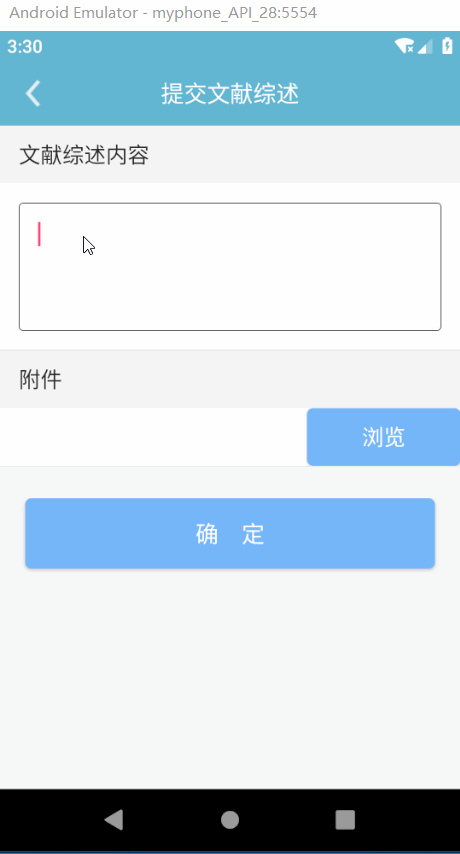纠结了好久的文件上传与下载功能,最近终于完美解决。心路历程简直不想提了,说多了都是泪。可能也是自己的知识掌握还不够吧,毕竟,很少做android方面的。
其实,在网上也找了很多关于这方面的资料,但是,可能和我理解的有些出入,项目中也是不能够很好的应用,导致花费了大量的时间。所以,有必要记录一下,怎么说呢?就是希望我踩过的坑能给大家一些帮助。
我自己的项目实例也是结合网上的一些资料,然后运用到自己的项目中的,其实我们需要注意的就是一些细节的地方,今天就先讲关于OKhttp实现文件上传:
咱们还是先看效果再继续往下说:

如果对效果还算是比较满意,那我们继续往下看,东西不多,就是要注意细节咯!
1. xml布局
相信这个就不用我多说了,我的布局也很简单,看到上面的图估计就能猜到。这里就不把代码贴出来了,简单说一下,两个文本框(界面上的 “文献综述内容” 和 “附件”),两个编辑框(就是你看到的两个输入框),两个按钮(选择文件的 “浏览”和 “确定”),轻松搞定。
还有就是读取文件的权限不要忘了。
2. activity中的实现
看到布局之后,想必操作你也是了然于胸了吧,我们需要给 “浏览” 这个按钮设置点击事件的监听,点击它后,需要打开我们的文件夹:
//打开文件选择器
private void showFileChooser() {
Intent intent = new Intent(Intent.ACTION_GET_CONTENT);
// 设置你要打开的文件type
intent.setType("application/*");
intent.addCategory(Intent.CATEGORY_OPENABLE);
startActivityForResult(intent, 1);
}对于,你要设置的setType,可以看看这个参考手册,我这里主要是为了选择文本类的文件,所以我才这么设置的,如果你支持所有类型,也可以改为 intent.setType( "*/*" ),这个看你自己的需要了。
然后,在它的后面别忘了:
@Override
protected void onActivityResult(int requestCode, int resultCode, Intent data) {
Log.w(TAG,"返回的数据:"+data);
if (resultCode == Activity.RESULT_OK) {
Uri uri = data.getData();
//使用第三方应用打开
if ("file".equalsIgnoreCase(uri.getScheme())){
path = uri.getPath();
file = new File(path);
uploadfile = file.getName();
mc_annex.setText(uploadfile);
Log.w(TAG,"getName==="+uploadfile);
Toast.makeText(this,path+"11111",Toast.LENGTH_SHORT).show();
return;
}
//4.4以后
if (Build.VERSION.SDK_INT > Build.VERSION_CODES.KITKAT) {
// 获取文件路径
path = getPath(this, uri);
Log.w(TAG,path);
file = new File(path);
// 获得文件名
uploadfile = file.getName();
// 这里是为了选中文件后,编辑框内容变成我选中的文件名
// 直接 mc_annex.setText(file.getName()); 也行
mc_annex.setText(uploadfile);
Log.w(TAG,"getName==="+uploadfile);
Toast.makeText(this,path,Toast.LENGTH_SHORT).show();
} else {//4.4以下下系统调用方法
path = getRealPathFromURI(this,uri);
Log.w(TAG,path);
Toast.makeText(StudentMiddleCheckEditActivity.this, path+"222222", Toast.LENGTH_SHORT).show();
}
}
}对了,别忘了定义变量,我是在一开始就定义了,所以,这里没有。然后,uploadfile单纯的就是为了得到文件的名字,因为我后面调接口的时候需要把文件名传过去。
private String path,uploadfile;
private File file;3. FileUtils 封装类
之前,我们能够很明显看到getPath(this, uri)的方法,那么这个方法是封装在哪呢?
我自己遇到的问题是什么,选中文件之后就报这样的错误:
E/AndroidRuntime: FATAL EXCEPTION: main
Process: com.will.manage_system, PID: 22879
java.lang.RuntimeException: Failure delivering result ResultInfo{who=null, request=1, result=-1, data=Intent { dat=content://com.android.providers.downloads.documents/document/raw:/storage/emulated/0/Download/会议记录9-12月.doc flg=0x1 }} to activity {com.will.manage_system/com.manage_system.ui.manage.activity.student.StudentMiddleCheckActivity}: java.lang.NumberFormatException: For input string: "raw:/storage/emulated/0/Download/会议记录9-12月.doc"
at android.app.ActivityThread.deliverResults(ActivityThread.java:4360)
at android.app.ActivityThread.handleSendResult(ActivityThread.java:4402)
at android.app.servertransaction.ActivityResultItem.execute(ActivityResultItem.java:49)
at android.app.servertransaction.TransactionExecutor.executeCallbacks(TransactionExecutor.java:108)
at android.app.servertransaction.TransactionExecutor.execute(TransactionExecutor.java:68)
at android.app.ActivityThread$H.handleMessage(ActivityThread.java:1808)
at android.os.Handler.dispatchMessage(Handler.java:106)
at android.os.Looper.loop(Looper.java:193)
at android.app.ActivityThread.main(ActivityThread.java:6669)
at java.lang.reflect.Method.invoke(Native Method)
at com.android.internal.os.RuntimeInit$MethodAndArgsCaller.run(RuntimeInit.java:493)
at com.android.internal.os.ZygoteInit.main(ZygoteInit.java:858)
Caused by: java.lang.NumberFormatException: For input string: "raw:/storage/emulated/0/Download/会议记录9-12月.doc"
at java.lang.Long.parseLong(Long.java:594)
at java.lang.Long.valueOf(Long.java:808)
at com.manage_system.utils.FileUtils.getPath(FileUtils.java:109)
at com.manage_system.ui.manage.activity.student.StudentMiddleCheckActivity.onActivityResult(StudentMiddleCheckActivity.java:293)
at android.app.Activity.dispatchActivityResult(Activity.java:7454)
at android.app.ActivityThread.deliverResults(ActivityThread.java:4353)
at android.app.ActivityThread.handleSendResult(ActivityThread.java:4402)
at android.app.servertransaction.ActivityResultItem.execute(ActivityResultItem.java:49)
at android.app.servertransaction.TransactionExecutor.executeCallbacks(TransactionExecutor.java:108)
at android.app.servertransaction.TransactionExecutor.execute(TransactionExecutor.java:68)
at android.app.ActivityThread$H.handleMessage(ActivityThread.java:1808)
at android.os.Handler.dispatchMessage(Handler.java:106)
at android.os.Looper.loop(Looper.java:193)
at android.app.ActivityThread.main(ActivityThread.java:6669)
at java.lang.reflect.Method.invoke(Native Method)
at com.android.internal.os.RuntimeInit$MethodAndArgsCaller.run(RuntimeInit.java:493)
at com.android.internal.os.ZygoteInit.main(ZygoteInit.java:858) 喏,再截个图:

但是,选择系统自带的文件是没有问题的,最后发现传过去的字段不符,其实也就加了一下几行代码:
if (id != null && id.startsWith("raw:")) {
return id.substring(4);
}好吧,直接把我改完之后的代码放上来:
package com.manage_system.utils;
import android.annotation.SuppressLint;
import android.content.ContentUris;
import android.content.Context;
import android.database.Cursor;
import android.net.Uri;
import android.os.Build;
import android.os.Environment;
import android.provider.DocumentsContract;
import android.provider.MediaStore;
import android.util.Log;
import java.io.File;
import java.io.FileInputStream;
import java.io.FileNotFoundException;
import java.io.FileOutputStream;
import java.io.IOException;
public class FileUtils {
private static String TAG = "FileUtils";
/**
* 专为Android4.4设计的从Uri获取文件绝对路径,以前的方法已不好使
*/
@SuppressLint("NewApi")
public static String getPath(final Context context, final Uri uri) {
final boolean isKitKat = Build.VERSION.SDK_INT >= Build.VERSION_CODES.KITKAT;
// DocumentProvider
if (isKitKat && DocumentsContract.isDocumentUri(context, uri)) {
// ExternalStorageProvider
if (isExternalStorageDocument(uri)) {
final String docId = DocumentsContract.getDocumentId(uri);
final String[] split = docId.split(":");
final String type = split[0];
if ("primary".equalsIgnoreCase(type)) {
return Environment.getExternalStorageDirectory() + "/" + split[1];
}
}
// DownloadsProvider
else if (isDownloadsDocument(uri)) {
final String id = DocumentsContract.getDocumentId(uri);
if (id != null && id.startsWith("raw:")) {
return id.substring(4);
}
final Uri contentUri = ContentUris.withAppendedId(
Uri.parse("content://downloads/public_downloads"), Long.valueOf(id));
Log.w(TAG,contentUri+"");
return getDataColumn(context, contentUri, null, null);
}
// MediaProvider
else if (isMediaDocument(uri)) {
final String docId = DocumentsContract.getDocumentId(uri);
final String[] split = docId.split(":");
final String type = split[0];
Log.w(TAG,docId);
Log.w(TAG,type);
Uri contentUri = null;
if ("image".equals(type)) {
contentUri = MediaStore.Images.Media.EXTERNAL_CONTENT_URI;
} else if ("video".equals(type)) {
contentUri = MediaStore.Video.Media.EXTERNAL_CONTENT_URI;
} else if ("audio".equals(type)) {
contentUri = MediaStore.Audio.Media.EXTERNAL_CONTENT_URI;
}
Log.e(TAG,"isMediaDocument");
final String selection = "_id=?";
final String[] selectionArgs = new String[]{split[1]};
return getDataColumn(context, contentUri, selection, selectionArgs);
}
}
// MediaStore (and general)
else if ("content".equalsIgnoreCase(uri.getScheme())) {
Log.e(TAG,"content");
return getDataColumn(context, uri, null, null);
}
// File
else if ("file".equalsIgnoreCase(uri.getScheme())) {
Log.e(TAG,"file");
return uri.getPath();
}
return null;
}
/**
* Get the value of the data column for this Uri. This is useful for
* MediaStore Uris, and other file-based ContentProviders.
*
* @param context The context.
* @param uri The Uri to query.
* @param selection (Optional) Filter used in the query.
* @param selectionArgs (Optional) Selection arguments used in the query.
* @return The value of the _data column, which is typically a file path.
*/
public static String getDataColumn(Context context, Uri uri, String selection,
String[] selectionArgs) {
Cursor cursor = null;
Log.w(TAG,"hh:"+uri);
final String column = "_data";
final String[] projection = {column};
try {
cursor = context.getContentResolver().query(uri, projection, selection, selectionArgs,
null);
Log.w(TAG,"hh1:"+cursor);
if (cursor != null && cursor.moveToFirst()) {
final int column_index = cursor.getColumnIndexOrThrow(column);
return cursor.getString(column_index);
}
} finally {
if (cursor != null)
cursor.close();
}
return null;
}
public static String getRealPathFromURI(Context context,Uri contentUri) {
String res = null;
String[] proj = { MediaStore.Images.Media.DATA };
Cursor cursor = context.getContentResolver().query(contentUri, proj, null, null, null);
if(null!=cursor&&cursor.moveToFirst()){
int column_index = cursor.getColumnIndexOrThrow(MediaStore.Images.Media.DATA);
res = cursor.getString(column_index);
cursor.close();
}
return res;
}
/**
* @param uri The Uri to check.
* @return Whether the Uri authority is ExternalStorageProvider.
*/
public static boolean isExternalStorageDocument(Uri uri) {
return "com.android.externalstorage.documents".equals(uri.getAuthority());
}
/**
* @param uri The Uri to check.
* @return Whether the Uri authority is DownloadsProvider.
*/
public static boolean isDownloadsDocument(Uri uri) {
return "com.android.providers.downloads.documents".equals(uri.getAuthority());
}
/**
* @param uri The Uri to check.
* @return Whether the Uri authority is MediaProvider.
*/
public static boolean isMediaDocument(Uri uri) {
return "com.android.providers.media.documents".equals(uri.getAuthority());
}
}
4. OKhttp 带文件传参
在OkManager里封装了一个方法:
public static void postFile(String url, RequestBody requestBody ,okhttp3.Callback callback)
{
OkHttpClient client = new OkHttpClient().newBuilder().connectTimeout(60000, TimeUnit.MILLISECONDS)
.readTimeout(60000, TimeUnit.MILLISECONDS)
.build();
// 取到我存放在SharedPreferences 的token
SharedPreferences sp=MyApp.getAppContext().getSharedPreferences("loginInfo", MODE_PRIVATE);
Request request = new Request.Builder()
.header("token",sp.getString("token" , ""))
.url(url)
.post(requestBody)
.build();
client.newCall(request).enqueue(callback);
}第一个client的时间设置,想必有看我之前这篇博文的小伙伴知道,是为了防止我们客户端不能及时响应服务器的数据,当然,不设置也是没啥问题的,只是说如果后台数据量过大,而我们又不能及时处理,可能会存在报错超时的情况。
而我自己将token存放在SharedPreferences里,也是为了添加header,因为自己项目的需要,用户登录成功之后,服务器会返回一个token,请求数据的时候需要将token放到请求头上,所以就是你上面看到的样子。当然了,关于这块,后面我们再详讲。
最后,说一下,requestBody,我把这个参数传进来的原因,是因为我需要在不同的地方调用。
哈哈,去掉了之后的简化版:
public static void postFile(String url, RequestBody requestBody ,okhttp3.Callback callback)
{
OkHttpClient client = new OkHttpClient();
Request request = new Request.Builder()
.url(url)
.post(requestBody)
.build();
client.newCall(request).enqueue(callback);
}总之,一句话,看你自己的需求。
那具体是怎么调用呢?如下:
OkManager manager = OkManager.getInstance();
RequestBody requestBody = new MultipartBody.Builder()
.setType(MultipartBody.FORM)
.addFormDataPart("intro", intro) // 提交内容字段
.addFormDataPart("uploadfile", uploadfile, RequestBody.create(MediaType.parse("*/*"), file)) // 第一个参数传到服务器的字段名,第二个你自己的文件名,第三个MediaType.parse("*/*")和我们之前说的那个type其实是一样的
.build();
manager.postFile(url, requestBody,new okhttp3.Callback() {
@Override
public void onFailure(Call call, IOException e) {
Log.e(TAG, "onFailure: ",e);
}
@Override
public void onResponse(Call call, Response response) throws IOException {
final String responseBody = response.body().string();
final JSONObject obj = JSON.parseObject(responseBody);
Log.e(TAG,obj.toString());
runOnUiThread(new Runnable() {
@Override
public void run() {
// 对返回结果进行操作
}
});
}
});对了,看到这我想起来,在OkManager里面还定义了一个获取对象的方法:
//采用单例模式获取对象
public static OkManager getInstance() {
OkManager instance = null;
if (manager == null) {
synchronized (OkManager.class) { //同步代码块
if (instance == null) {
instance = new OkManager();
manager = instance;
}
}
}
return instance;
}至此,文件上传应该是没什么问题了。下一篇我们接着讲OKhttp实现文件下载。























 1165
1165











 被折叠的 条评论
为什么被折叠?
被折叠的 条评论
为什么被折叠?








